Warning: Spoilers ahead for the Amazon Prime Video series, The Wheel of Time
The Wheel of Time, a fantasy TV show based on the novel series of the same name by Robert Jordan, premiered Nov. 19 on Amazon Prime Video, bringing new audiences and longtime fans alike to an adaptation of an expansive story. Developed by Rafe Judkins and starring Rosamund Pike, The Wheel of Time centers on five young people—Rand al’Thor (Josha Stradowski), Egwene al’Vere (Madeleine Madden), Perrin Aybara (Marcus Rutherford), Nynaeve al’Meara (Zoë Robins) and Matrim Cauthon (Barney Harris)—from a remote village called the Two Rivers.
On the eve of Bel Tine, a holiday celebration, a woman named Moiraine appears in the village. She is recognized as an Aes Sedai, one of the alternately revered and feared women who can channel the One Power. That night, the village is brutally attacked by monsters called Trollocs, and Moiraine is instrumental in defeating them. In the aftermath of the attack, Moiraine tells the young villagers that it is one of them who the Trollocs were seeking, and convinces them to leave and travel with her to the Aes Sedai’s stronghold, the White Tower, in the faraway city of Tar Valon.
I have previously written about why the book series has so many fans, as well as the ways in which I hoped that the TV series would fulfill our fannish dreams of seeing the books’ story come to life. Having watched the first three episodes of the show, I have some answers to that latter question.
My immediate reaction to the first three episodes of The Wheel of Time can be divided into three categories: the good, the neutral/ambiguous and the bad. There’s plenty of all three to be found in the series.
What The Wheel of Time does well
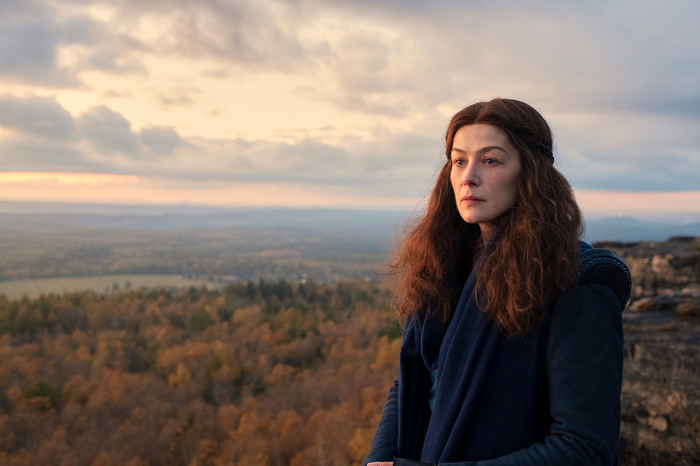
The production design is gorgeous
I know there are those who are using this point as a way to damn the show with faint praise, but I do not mean it that way: the show is beautiful to look at, and I appreciate that. The scenery, cinematography, music, set design, costumes and special effects are, so far, spectacular. Some criticize CGI, arguing it takes the magic out of bringing fantastical elements to life on screen, but I am not one of them: Give me all the lovely post-apocalyptic landscapes and actually convincing monsters. The designs of the Trollocs and the (so far singular) Fade are especially effective—and scary.
The opening credits, while similar to A Game of Thrones’, symbolize the plot
The Wheel of Time’s opening credits have been criticized for somewhat copying the credit sequence to A Game of Thrones. And, yes, they definitely share some elements. But while A Game of Thrones’ opening credits were mesmerizing to watch, it was never clear how the clockwork map thing was supposed to be symbolic of the series’ themes. The Wheel of Time’s opener, on the other hand, actually portrays the central themes of the story, with imagery of weaving tapestries and depictions of the Aes Sedai and the seven Ajahs (references that will become clearer as the series goes on).
The Wheel of Time’s showrunners update the story in terms of diversity and equality
The first three episodes deliver on the show creators’ promises that they would update the story in terms of diversity and equality. By casting people of color in key roles and overtly erasing some of the gender lines installed and maintained by the source material, the showrunners have updated the story for the 21st century.
In the opening voiceover, Moiraine Sedai says directly that while the Dragon is reborn, they do not know whether they were born as a girl or a boy, and she also tells her Warder Lan that there are four “ta’veren” (a term expected to be made clear for non-book readers later) in the Two Rivers: Rand, Mat, Perrin, and Egwene. In the books, only the three boys were explicitly named ta’veren and Egwene was not, a thing which was bitterly argued over by fans of the books as being contradicted by the events of the story. In my opinion, it’s an authorial oversight that I was very pleased to see corrected, and am interested to see how the decision ends up reverberating through future events.
A more passing but still appreciated correction is that where the books rarely mentioned homosexuality, the show has made a point of establishing that same-sex relationships are both acknowledged and common early on.
The Wheel of Time brings to life important plot points from the book series
This may seem a little opaque to non-book fans, but: Moiraine told the story of Manetheren! She didn’t tell it in quite the same way as she did in the books, and it was edited down to some extent, but that doesn’t matter. Moiraine telling the Two Rivers folk the story of their own ancestors, that they had entirely forgotten until she brought it back to life for them, was one of the earliest scenes in The Eye of the World that gave hints of the sheer depth of its world-building, and it was also what firmly hooked me into reading further, and I love that the show kept it in. I love it for itself, but I also love that it suggests the showrunners recognized the scene’s importance, which bodes well for the future, I hope.
I also love that the show keeps “The Sentence”: the famous first sentence of every first chapter of every book in the entire series, which always starts the same and ends slightly differently for each book. The Eye of the World’s version goes:
The Wheel of Time turns, and Ages come and pass, leaving memories that become legend. Legend fades to myth, and even myth is long forgotten when the Age that gave it birth comes again. In one Age, called the Third Age by some, an Age yet to come, an Age long past, a wind rose in the Mountains of Mist. The wind was not the beginning. There are neither beginnings nor endings to the turning of the Wheel of Time. But it was a beginning.
Adding the line at the end of the pilot episode was the perfect touch.
Rosamund Pike is a great Moiraine
As Moiraine, Rosamund Pike shoulders much of the emotional weight of the story so far—and is doing it well. Moiraine has continually been a fan favorite character throughout the book series, so it’s gratifying to see her treated with such respect by Pike.
I also like the relationship between Moiraine and her Warder Lan in the show, which is a tad, ahem, cheekier than it was in the books. (If you’ve seen the bathtub scene, you know what I’m talking about.)
These guys are awful
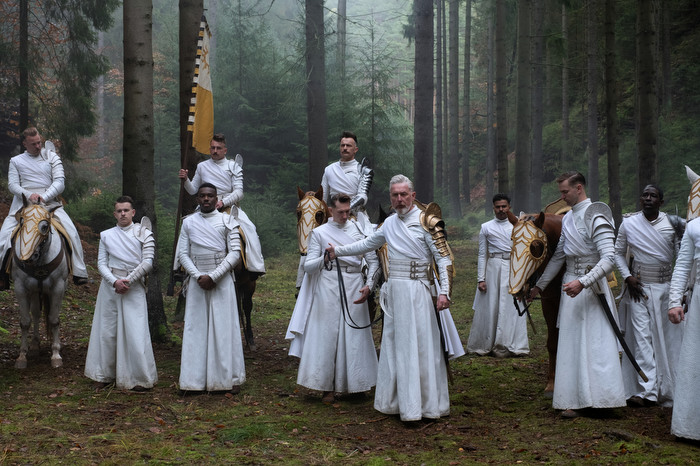
It might seem strange that this goes in the “Good” category, but the Whitecloaks are awful, terrible people in the books, and they are awful, terrible people in the show, and that’s great because a good story needs good villains. The Children of the Sun, as they are more formally known, are essential to the story’s overall themes about good and evil: that even in a world where evil is extant and literal, humanity is still capable of creating its own evil, which in some ways can be even worse. Their costume design in the show is especially effective, evoking real-world references that fans have long speculated them to be based on (in particular, the Knights Templar and the Ku Klux Klan).
The Wheel of Time adaptation makes choices that depart from the books—but I’m mostly fine with that
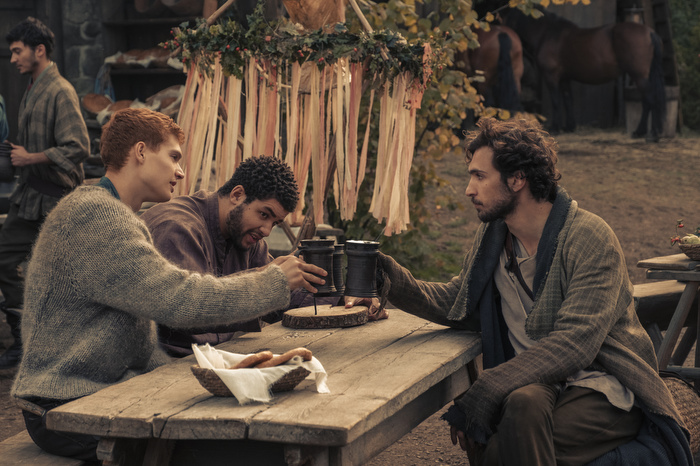
Our Young Untried Heroes come across as more mature than they did in the books
I was surprised to find that Rand, Mat, Perrin and Egwene are the same age at the start of the TV show as they are at the start of the book series (The boys are 20 years old and Egwene is 18). In the books, the characters act much younger than typical 18-20 year olds. Robert Jordan wrote the Two River characters, with the exception of Nynaeve, as much more innocent about things like sex than their TV counterparts portray. In the show, Rand and Egwene are in an established sexual relationship from the start, and Perrin is actually married with a child on the way. At first, this struck me as a somewhat obviously pandering change for the TV audience; but realizing now the characters are around age 20 in the books as well, I have to agree with the show’s decision to make them act their age.
There is no Prologue
The Eye of the World starts with a Prologue, set some 4,000 years before the main action of the books begin, and I have long been on the fence over whether it would be a good idea to include it or not in the TV adaptation. But as it turns out, they didn’t include it, and I… am pretty much fine with that decision. We’ll have to see if it will show up at some later point.
Holy compressed timeline, Batman!
Just about everyone has predicted that the TV show was going to have to do some major surgery on the plot of the books in order to complete it in any kind of sane time frame, and the first three episodes certainly appear to bear this assumption out. I’m fairly certain that the end of the third episode puts us roughly halfway through the entire first book, so they are definitely trucking right along.
While this was inevitable, it raises questions about how the show will deal with fairly major characters, like Bayle Domon, Elyas Machera and Min Farshaw, whose introductions in the first book have already been skipped over. That said, Thom Merrilin (who originally joined the cast in the Two Rivers) was simply introduced later, so we’ll likely see Min et al at some point. Hopefully.
What The Wheel of Time show gets wrong
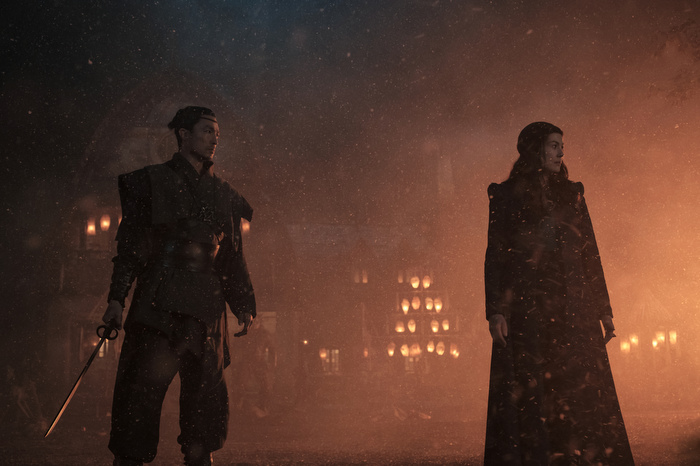
The tone of the show is way more A Game of Thrones than not
I’ve previously discussed how one of the stronger aspects of The Wheel of Time is how it is unlike A Game of Thrones, tonally, but the TV show begs to differ. While the WOT books have plenty of dark, serious moments, and even many that qualify as horrific (it is a story about the potential end of the world, after all), there are also plenty of moments of lightheartedness and affection and humor to balance it out. The show, however, has so far erred on the dark and grim side of things.
I acknowledge that it’s a tough spot for the show—dancing back and forth across the line between comedy and drama is tricky to pull off in any context, but especially so in fantasy. And A Game of Thrones was a monster behemoth success, and no doubt everyone would like to get on that gravy train. But running around trying to reach the place lightning last struck, in the hopes that it will strike the same place again, is a fool’s game. The Wheel of Time’s story would be better served establishing its own style rather than imitating that of another.
They cut the opening scene with Rand and the Fade
In the books, the first chapter (after the Prologue) opens with Rand al’Thor and his father Tam on the road from their isolated farm to the village. As they travel, Rand begins to feel like they are being watched:
He glanced over his shoulder… and blinked. Not more than twenty spans back down the road a cloaked figure on horseback followed them, horse and rider alike black, dull and ungleaming.
[…] The rider’s cloak covered him to his boot tops, the cowl tugged well forward so no part of him showed. Vaguely Rand thought there was something odd about the horseman, but it was the shadowed opening of the hood that fascinated him. He could see only the vaguest outlines of a face, but he had the feeling he was looking right into the rider’s eyes. And he could not look away. Queasiness settled in his stomach. There was only shadow to see in the hood, but he felt hatred as sharply as if he could see a snarling face, hatred for everything that lived.
[…] Abruptly Rand realized what had been odd about the horseman, aside from his being there at all. The wind that beat at Tam and him had not so much as shifted a fold of that black cloak. His mouth was suddenly dry. He must have imagined it.
This is probably going to seem very nitpicky to non-book fans, but I have been waiting something like 20 years to see this scene realized on screen… and we didn’t get it. Instead, the black rider shows up at the village, and (initially) only the audience sees him.
Yes, it’s a minor thing. And I even understand why the show made that decision, as part of streamlining events to move them along more quickly. But silly as it may be, not getting that moment was a letdown.
Mat Cauthon is angsty and sad, and that makes me sad
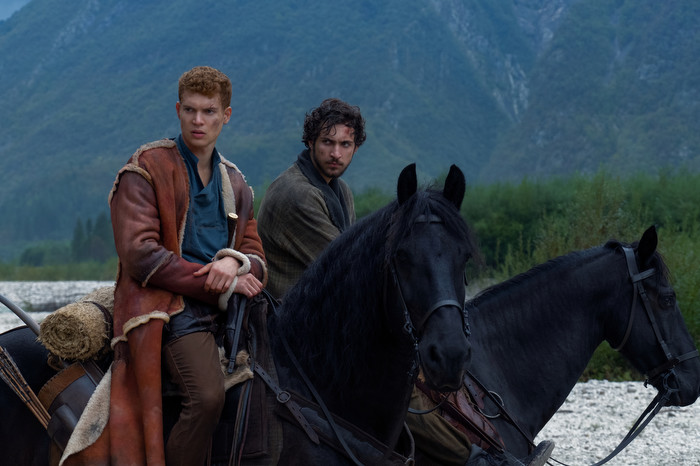
I have some sympathy for the show here: the character of Mat Cauthon is extremely difficult to get a handle on. He is by far one of the most popular characters in the series, and a frequent source of its humor, but author Robert Jordan’s brand of comedy was often idiosyncratic and oblique at best, and the things which made Mat awesome in the books are very easy to get wrong. Even Brandon Sanderson, who finished the books after Jordan died, had a struggle at first getting a grip on how to write the character.
That said, it’s not clear the show is even trying. Instead of the merry, carefree and occasionally obnoxious trickster Mat is at the beginning of the books, the first three episodes show us a Mat who is more of an outright criminal than a trickster, with an abusive homelife, a sullen and shady mien, and a nearly incomprehensible accent. Admittedly, maybe that last is just me, but I swear I could hardly understand a word Barney Harris said (and sadly, I was not afforded subtitles to help me out).
The show is re-casting Mat for Season 2, and while switching actors for such a major role that early on is not generally a great sign, based on what I’ve seen so far, it might be the right decision.
Aren’t we done fridging women?
It’s the oldest, tiredest, dreariest misogynist trope in fiction: killing off a male character’s wife/daughter/girlfriend/momentary sexual conquest for the sole purpose of driving the male character’s development, by giving him a trauma to overcome. The only reason Perrin’s pregnant wife (an entirely original character who didn’t appear in the books) even exists is so that she can be immediately brutally murdered—by Perrin’s own hand, no less!—so he can be devastated by it. What’s the wife’s name? No idea. It’s not like it matters, does it?
This is, in a word, gross. Not to mention completely unnecessary. And it’s especially egregious that the show would stoop to such a cheap and sexist ploy at the same time it is touting its moves toward gender parity in other respects. Bad form, show.
(And as a side note, the last thing Perrin’s character needs is more reasons to be emo. Trust me; if there is one thing I could change about the books, it’s how long we end up watching Perrin angst and mope and drama llama all over the place, and now you’ve also given him “accidentally murdering his own wife and unborn child” to contend with? Ugh.)
There are some other, more minor issues I had (Did Mat really just find the Shadar Logoth dagger in a random corner? How on earth does throwing someone into extremely dangerous rapids make sense as an initiation ceremony?), but they’re mostly just nitpicks in comparison to the bigger points above. Overall, despite the genuinely bad choice to kill Perrin’s wife, I enjoyed The Wheel of Time and look forward to seeing where it goes. As a longtime fan of the series, who has been waiting for literal decades to see this on screen, though, I am perhaps more invested than the average viewer. It’s tough to say whether non-book fans will feel as excited.
However, even with my relative lack of objectivity, I feel that Amazon’s The Wheel of Time has potential to be great, even if it wasn’t quite that right out of the gate. With a chance to sharpen up and become more of itself and less like its cinematic predecessors, the show should find its own feet and ways to be awesome.
It wasn’t maybe the beginning I thought it would be, but it was a beginning. And I love that.
Leigh Butler is a writer, blogger and critic, who examines the impact of sociocultural issues on popular science fiction and fantasy works (and vice versa). She has been a regular columnist for Tor.com since 2009, with three series (so far) to her name: The Wheel of Time Reread, A Read of Ice and Fire, and the Movie Rewatch of Great Nostalgia. She lives in New Orleans.
More Must-Reads from TIME
- Cybersecurity Experts Are Sounding the Alarm on DOGE
- Meet the 2025 Women of the Year
- The Harsh Truth About Disability Inclusion
- Why Do More Young Adults Have Cancer?
- Colman Domingo Leads With Radical Love
- How to Get Better at Doing Things Alone
- Michelle Zauner Stares Down the Darkness
Contact us at letters@time.com